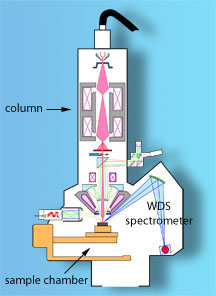An electron microprobe (also known as an Electron Probe MicroAnalyzer or EPMA) can be viewed as an electron microscope surrounded by analytical spectrometers. It has an electron column in which an electron beam is produced and focused onto the surface of the sample. The samples and standards to be analyzed are located on the stage in the sample chamber, and when the high energy electrons of the beam hit the sample, characteristic X-rays are produced. These X-rays can be used to identify the elements present in the sample and to quantify their abundance. On an electron microprobe, the X-rays are measured using wavelength dispersive spectrometers (WDS) which sort the X-rays based on their wavelengths.
|
Figure 1. Schematic of a JEOL |
